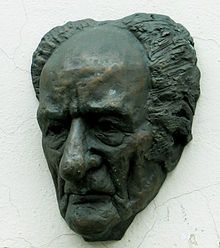Koloman Sokol
Koloman Sokol (born December 12, 1902 in Liptovský Mikuláš , Liptov County ; † January 13, 2003 in Tucson , Arizona , USA) was one of the leading Slovak artists of the 20th century .
Life
From 1921 to 1924 Sokol attended the private school Eugen Króns in Košice and a year later the school Gustav Malýs in Bratislava . At the Art Academy in Prague he studied between 1925 and 1932 a. a. with Max Švabinský and Tavík František Šimon , followed by a one-year study in Paris with František Kupka . Several stays abroad followed, and in his home country he became a member of SČUG Hollar , an association of Czechoslovak graphic artists.
The Mexican Ministry of Culture and Education invited him in 1937 to teach graphics at the School of Book Art and the Universidad Nacional Autónoma de México in Mexico City . Sokol held this position for four years until he moved to the USA in 1942 and continued teaching in New York . He returned to Bratislava for two years in 1946 and taught at the Slovak Technical University in Bratislava and at the Comenius University in Bratislava . In 1948 he went back to the United States. He settled in Bryn Mawr , a suburb of Philadelphia . From the 1960s he lived withdrawn from the outside world and developed a special symbolic-mythological style during this time. The last years of his life he resided in Tucson, where he died at the age of 100.
Typical of Sokol's work was the powerful expressionist style that placed people at the center and often took up social problems. Above all, woodcuts were made by him. Well-known works are z. B. Na konci mesta (On the outskirts of the city), Osúdená (convicted), Starý pltník (The old raftsman), V ateliéri (In the studio), V uličke (On the street) and Za cieľom (To the goal)
Web links
- Literature by and about Koloman Sokol in the catalog of the German National Library
- Koloman Sokol (Slovak)
Individual evidence
- ↑ Vlado Simko: Koloman Sokol: The life of an artist in exile (PDF) Archived from the original on January 3, 2011.
| personal data | |
|---|---|
| SURNAME | Sokol, Koloman |
| BRIEF DESCRIPTION | Slovak artist |
| DATE OF BIRTH | December 12, 1902 |
| PLACE OF BIRTH | Liptovský Mikuláš , Slovakia |
| DATE OF DEATH | January 13, 2003 |
| Place of death | Tucson , Arizona, USA |
